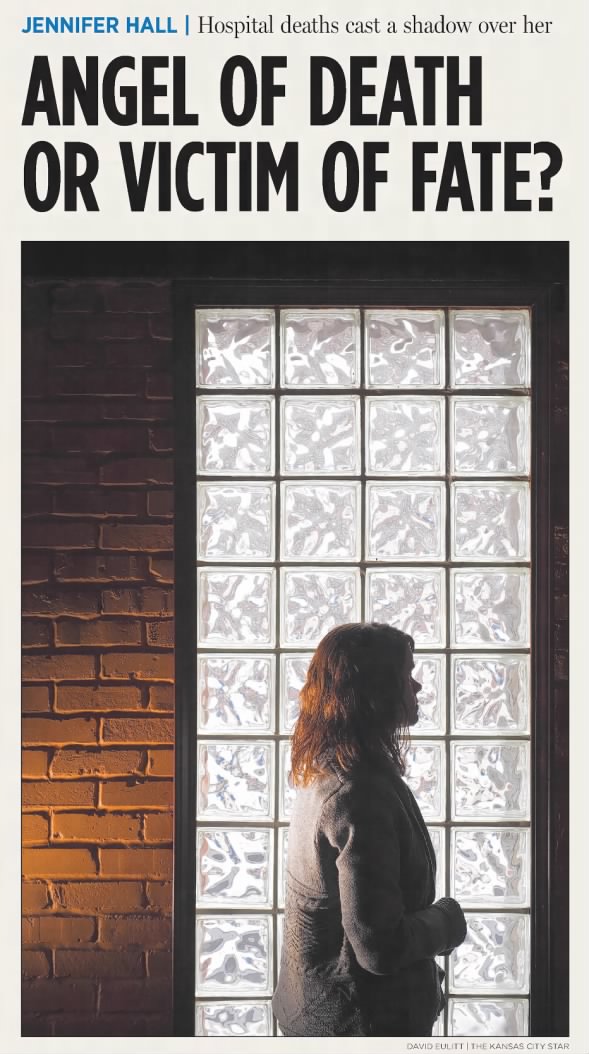CHILLICOTHE, Mo. — A former Missouri respiratory therapist accused of killing a patient in 2002 — and suspected in the deaths of eight more — has previously spent a year in prison for arson, a crime of which she was later exonerated.
Jennifer Anne Hall, 41, of Overland Park, Kansas, was arrested Thursday in Kansas and booked into jail to await extradition proceedings. Hall is charged with first-degree murder in the May 18, 2002, death of Fern Franco.
Hall, who was arrested under the name Jennifer Semaboye, was also charged with identity theft. According to KMBC in Kansas City, Hall waived extradition in a court hearing on Friday.
Records show that she has since been transferred back to Missouri and booked into the Livingston County Jail to await trial. She is being held without bond.
Franco, 75, was a patient at Hedrick Medical Center in Chillicothe when she was allegedly slain. Authorities believe Hall injected the elderly woman with succinylcholine, a paralytic agent.
Hall, who had been at the hospital for six months, was placed on administrative leave, and later fired, following Franco’s suspicious death.
At the time of the string of deaths at Hedrick, Hall had been convicted of setting a fire at a previous hospital where she worked. She was free on appeal bond when she allegedly killed Franco.
Angel of Death?
Hall was a 20-year-old, new respiratory therapist on Jan. 24, 2001, when a fire broke out in the respiratory therapy room at the Cass Regional Medical Center in Harrisonville. According to the National Registry of Exonerations, Hall was the sole therapist on duty at the time.
“She told authorities that she was outside, getting a soda from her truck, when she heard the fire alarm sound,” Hall’s registry page states. “She rushed back into the building and, along with two other employees, Violet Warren and Mark Berry, turned off the oxygen valve in the room to prevent an explosion.”
Investigators became suspicious of Hall when they noticed a burn on one of her hands. Hall told them Berry, while responding to the fire, had lost his balance and bumped into her, causing her to catch herself on a hot metal door frame.
Based on the burn and an “unusual amount of charred paper near the fire,” and next to Hall’s desk in the therapy room, Hall became a prime suspect. An extensive 2014 story by the Kansas City Star stated that authorities also learned that Hall was unhappy with the results of a sexual harassment complaint she’d lodged against a male coworker.
The coworker, 51, did not get anything but a verbal admonishment, the newspaper reported. The man died of a heart attack the day after the scolding, which took place two weeks before the fire.
Three weeks after the fire, investigators arrested Hall and charged her with first-degree arson.
The state’s case against Hall, described as a weak one by the judge, commenced in September 2001. Hall’s defense attorney, who she hired on the recommendation of a relative, failed to examine the evidence and “routinely mixed up facts, dates and names at trial,” the exoneration registry states.
The prosecution argued that Hall had set the fire to become a hero when she extinguished it. The Star reported that one factor they pointed to was an unusual one: Hall’s hair.
She arrived at work the night of the fire with a new, curly hairstyle. Prosecutors claimed she changed her hair to look good on television when she was praised for extinguishing the fire.
Hall took the stand in her defense and denied committing the crime, but it took jurors just over five hours to find her guilty of a lesser charge, second-degree arson, the newspaper said.
On the advice of her attorney, Hall spoke during her sentencing hearing and, according to the exoneration registry, falsely stated that she’d set the fire by accident when she dropped a cigarette. She was sentenced to three years in prison.
Her family immediately hired a new defense lawyer, Matthew O’Connor. O’Connor, who is also representing Hall on the murder charge, filed an appeal and secured her release on bond while the appeal worked its way through the system.
In December 2001, three months after her arson conviction, Hall began her job at Hendrick Medical Center.
The first of the allegedly suspicious deaths took place in February, when a female patient died after a sudden dangerous drop in her blood sugar levels. Her doctor would ultimately suspect Hall, the Star reported.
Registered nurse Aleta Boyd, who was also a risk manager for the 49-bed hospital, was also suspicious of Hall’s behavior.
“She liked code blues,” Boyd would later testify.
Dr. Cal Greenlaw, the doctor whose patient had died Feb. 18, 2002, agreed in a 2013 civil deposition.
“She would come in saying, ‘I think we’re going to have excitement tonight,’” Greenlaw said, according to the paper. “Sure enough, someone would code.”
Boyd testified that the hospital normally saw an average of three code blues in a quarter. After Hall arrived, those numbers spiked, and there were five codes in February alone.
In March, there were six additional codes and three deaths, the Star reported.
“Each time you look at a (patient’s chart), Jennifer Hall is the common denominator.”
The Livingston County coroner would later cite 18 suspicious code blues over a 14-week period. Nine people died.
Seven families of the dead ultimately sued the hospital. St. Louis Public Radio reported, however, that the Missouri Supreme Court in 2019 determined that the lawsuits were filed long past the statute of limitations had expired.
Despite months of suspicion, it would be Franco’s death that led the hospital to place Hall on leave. She was fired in February 2003.
Time in prison
That summer, Hall’s appeal in the arson case was denied and she was sent to a maximum-security prison.
O’Connor, then her appeals lawyer, hired an expert who examined the evidence in the case, including a clock that had been in the respiratory therapy room at Cass Regional Medical Center. The expert, Carl Martin, immediately saw something odd.
According to Justice Denied, a magazine about wrongly convicted defendants, a bead of copper on the cord indicated that the clock had short circuited.
“Everything was very consistent with it being a long-term short circuit in a very old power cord, on an old clock very near the fire’s origin,” Martin told the magazine. “It was black and white after we tested it.
“There was no other way. Unfortunately, the investigators and police and the prosecutors were unable to see that. I don’t know if they had bad vision. I don’t know why they chose not to consider the most significant piece of evidence they had.”
As for the large amount of charred paper found in the therapy room, Martin pointed to a plastic paper tray that melted in the fire. He surmised that the paper had fallen from the tray and burned.
The Missouri Court of Appeals affirmed Hall’s conviction in 2003, but in 2004, the trial judge who heard Hall’s case found that Hall’s trial counsel had been inadequate.
The guilty verdict was overturned, and Hall was granted a new trial. Despite the fact that she could not serve more time if convicted, the prosecution moved forward.
The jury at her second trial found her not guilty in 2005.
Meanwhile, the suspicions about the string of sudden deaths at Hedrick continued. According to the Star, county Coroner J. Scott Lindley believed that the patients may have been poisoned, either with insulin or succinylcholine.
In certain circles, succinylcholine has been described as a near-perfect murder weapon. The drug, which is typically used in conjunction with anesthesia in surgery, paralyzes respiratory muscles.
In a proper dosage, succinylcholine halts breathing long enough for a patient to be intubated. In an overdose, it halts lung function until the person suffocates.
The drug is notoriously hard to detect after death because of the speed with which it breaks down.
According to Lindsey, lab tests found succinylcholine in Franco’s kidney tissue, the newspaper reported.
>> Read more true crime stories
By 2011, word had started spreading in Chillicothe that there were suspicious deaths at the hospital years before. The families of the dead, upon learning of the allegations against Hall, were stunned.
“Complete shock,” Sherri Harper told the paper about the news.
Harper’s husband, David Harper, was the youngest of the patients to die suspiciously. David Harper, who was being treated for pneumonia, was set to be released when he suddenly died.
His loved ones were not prepared to learn his death may not have been due to natural causes.
“We were devastated,” Sherri Harper said. “I couldn’t stop shaking.”
Hall has denied the allegations against her.
“Never,” she told the Star in 2014. “My name is just thrown out there, and it’s for horrifying reasons.”
After his client was charged with Franco’s murder, O’Connor told St. Louis Public Radio that the charge was baseless. He also said that those who believe Hall to be guilty have tried for years to bring criminal charges, but there is no evidence tying his client to the patient deaths.
“It is absolutely devastating to my client and her family and myself, frankly, to have a case that is without merit whatsoever and based on conjecture and speculation,” O’Connor said. “This isn’t lawyer talk. There aren’t facts in support of it because Ms. Hall did not commit these acts.”
According to the probable cause statement, detectives relied on Hall’s proximity to the patients at the time that each died.
“Because of Hall’s singular proximity to stricken patients, her access to pharmaceuticals which are deadly if misused and her discovery and method of notifying staff of every patient’s cardiac emergency, nursing staff believed Hall was responsible for the patient deaths,” the statement read.
©2022 Cox Media Group









